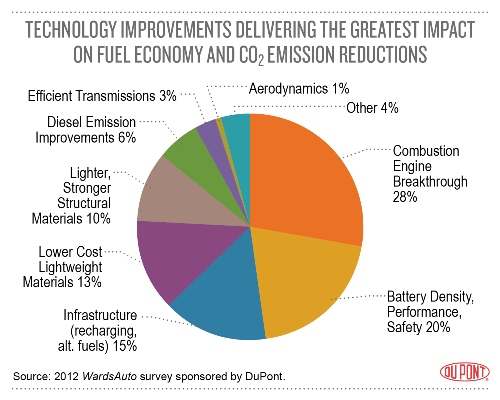The 2012 WardsAuto survey results revealed that automakers have increased their focus on reduction of vehicle weight, electrification of vehicles, and optimization of internal combustion engines to fulfill proposed Corporate Average Fuel Economy Standards (CAFE).

DuPont sponsored the survey and the results were presented in the Center for Automotive Research’s Management Briefing Seminar. Around 700 WardsAuto’s subscribers participated in the survey intended to track the effect of 2025 CAFE changes. The adoption of the new regulations will result in the doubling of fuel economy and reduction in emissions by 50% when compared to 2010 model year automobiles.
According to DuPont Global Automotive Industry Director, Chris Murphy, aggressive development and implementation of higher efficiency technologies are essential to achieve these goals. A strong partnership is required throughout the value chain and across the world.
For this purpose, DuPont created a worldwide collaboration network to establish connection between industry requirements and over 9,500 DuPont researchers and engineers working in over 150 technical centers across the world. Moreover, DuPont’s automotive materials science and international development teams have been organized to work on alternative drive systems, electrification, bio-based solutions, engine efficiency, and lightweighting to enable the industry make fuel-efficient, low-emission vehicles without sacrificing cost, comfort, safety or performance.
Around 30% of the respondents stated that advancement in combustion engine technology may have the highest impact on optimizing fuel economy and lowering emissions. DuPont Global Powertrain Segment Director, Mike Day stated that extensive research is ongoing on technologies such as homogeneous charge compression ignition systems, direct injection, lift programs, valve timing and turbo systems to efficiently control air flow.
Respondents were questioned if there is gap between which one is driving vehicle development –fuel prices, affordable technology, consumer preference, cost or regulations – and what must be driving development.
Murphy stated that there is a drastic difference in alignment this year when compared to 2011 results in which around 50% of the respondents informed that development is being driven by the government whereas new vehicle development should be driven by the consumer. This year’s disconnect is narrow. Increase in sales of fuel-efficient vehicles indicates that consumers are also willing to buy them even if cost is higher in some cases. This greater alignment, although not perfect, assists automakers to develop low-cost less-fossil-fuel-dependent vehicles that people willing to buy.